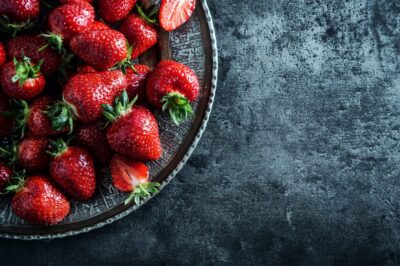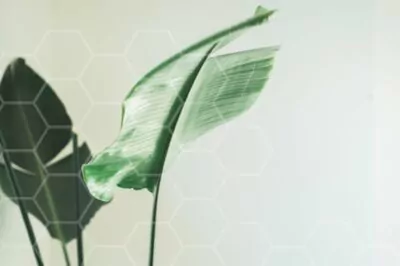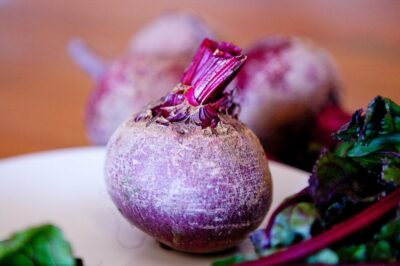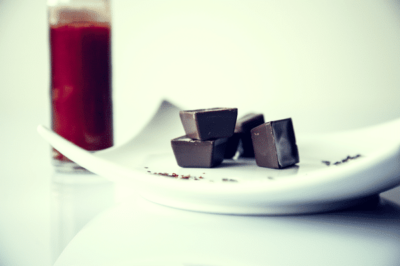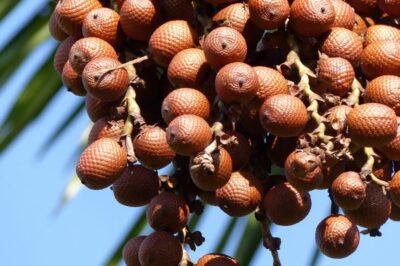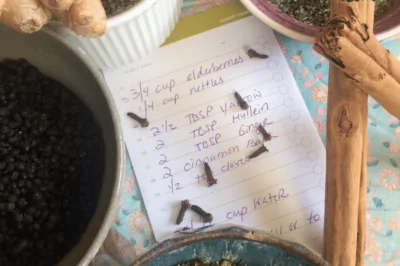The energy of the color red is strong and powerful. It is the color of drive and ambition, so it inspires confidence and the color of physical movement, waking up our life force.
When our red energy is balanced nurtured, our passions are stimulated and our creativity can flow. If there is too much red energy or if it’s being smothered, we tend to get agitated and aggressive and if there isn’t enough we are slower, fearful, and manipulative.
Talking about the color red in an energetic form is fun and it’s something to play around with, but it isn’t all that different to talk about it in a physical form. For instance, all of the red foods out there.
What Makes Food Red
I’m sure that you’ve heard the nutritional guideline, “eat the rainbow,” and we gotta say—it’s pretty sound advice.
The colors in our foods come from the most dominant phytochemicals in a plant, which are active components in the makeup of a plant. That means that color of an edible part of a plant totally indicates what type of nutrition you’ll get from it—pretty cool right?
The color red comes from the lycopene and anthocyanins in a plant and like with the energetics of the color red, these phytochemicals are stimulating and have a large impact on our physical well-being.
What are Antioxidants and Why Do We Need Them?
5 Herbal Smoothie Recipes for Radiant Skin
The Best Fruits to Eat if You’re Cutting Back on Sugar
Lycopene
Lycopene is a singular pigment within a family of plant pigments called carotenoids and is responsible for the red color in our fruits and veggie—while the larger, umbrella carotenoid family is responsible for the warmer colors of the rainbow (oranges, yellows, reds, etc) and have all been shown to have potent antioxidant activity.
Lycopene has been extensively studied over the past several decades. Eating foods high in this fat-soluble phytochemical (meaning that in order for our bodies to uptake it, it does need to be eaten with a fat) is correlated with a reduced risk of various cancers, including prostate, breast, and lung cancers due to its ability to bind to and deactivate insulin-like growth factors (IGF)—these are the cells that often become cancer cells.
Increased plasma lycopene levels have also been correlated with lower cardiovascular disease and lower cholesterol—since studies are showing that lycopene in the diet can help to increase the breakdown of low-density lipoproteins (LDL cholesterol, the kind that builds up) in the body.
Thinking back to the energy qualities of the color red that we talked about—it only makes sense that this plant-based magical pigment is correlated with reducing two of the most deadly diseases through fiercely stimulating, driving out, and breaking down the potential harm. Pretty cool, right? Considering that cancer and cardiovascular disease are two leading causes of death in our country, it seems like adding lycopene-rich foods to your diet is a good idea.
Anthocyanins
Another red colored phytochemical is anthocyanin. The term “anthocyanin” is actually another umbrella term that encompasses a lot of different chemical components—parsing out the components of a type of compound can get pretty scientific, so we’ll just leave you with knowing that we’re talking about more than one type of compound here.
It has been notoriously difficult to track down exactly what anthocyanins do because they actually seem to increase the bioavailability (the ease of which a nutrient from food can incorporate into your body) and power of other types of phytochemicals (there’s that red power again) but studies are starting to suggest some really amazing biomedicinal properties of these little red guys.
One oft-touted benefit is the intense antioxidant and free-radical scavenging actions. As if that wasn’t enough, anthocyanins are now being studied for DNA protection, fighting estrogen-dependent diseases, anti-inflammatory response stimulation, and their role immune system regulation.
Each of these things on their own makes this an amazing group of phytochemicals, but put them together and the health benefits are incredibly powerful. I don’t think I’ll be missing a day of natural reds ever again.
4 Red things to take note of
I think the best news of all is that getting red into your diet is super easy (and yummy). Here are 4 delicious red foods that you may have taken for granted before, but now you have an idea of what they’re actually doing for you.
Strawberries
Okay, this is a no-brainer. Wild strawberry is literally a Crayola color. They’re the only fruit with their seeds on the outside (which I think is totally cool) and they are super high in anthocyanins and other bioavailable antioxidants. Strawberries provide a good amount of fiber and contain minerals like potassium, magnesium, and phosphorus.
Pomegranate
Pomegranate fruit, especially the juice, is another antioxidant-dense red food. The amount of anthocyanins, tannins, and ellagic acid in pomegranate juice is so high that it pushes the fruit into superfood territory because it reduces damage from inflammation and combats oxidative stress—making it great for heart health.
Capsicum Peppers
So much for the sweet things, I wanted to include some spice for you too. Capsicum peppers, like red bell peppers and cayenne have lycopene and anthocyanins along with a whole host of other essential minerals like iron, copper, zinc, and potassium.
Cayenne in particular is the epitome of the red energy—passionate, stimulating, spicy, and really good in moderation (I think we know what happens when we eat too much cayenne). Eaten on a regular basis, it can help to regulate LDL cholesterol in obese individuals while the selenium content and blood stimulating properties are awesome for increasing heart health and breaking up stagnancy in the liver.
Tomato
Fun fact: most of the studies on lycopene are done on tomatoes because more that 80% of the lycopene intake in the US is in the form of tomatoes. Cooked tomatoes are actually higher in bioavailable lycopene because processing tomatoes reduces water content and thus increases the concentration of the phytochemical.
Tomatoes actually have all of the major carotenoids in them, not just the lycopene, and because they are all present, they work synergistically together to boost the antioxidant capacity and health benefits of the fruit. Tomatoes also have a good amount of potassium, which can be hard to come by in a standard American diet, and is essential for our nervous system to communicate to our musculoskeletal system (so that our brain can make our movements happen). Did that make anyone else want pasta?
Your Daily Dose of Reds from RealDose Nutrition
Okay, if I haven’t convinced you that red foods are the way to go by now, it isn’t going to happen. Hopefully, your eye will be drawn to the bunch of red grapes, the bucket of strawberries, and the hot section of the spice rack but if you’re looking for an easy way to add red benefits to your day without the struggle to change your recipe books, we have just the answer for you.
RealDose Nutrition has a product called RealReds that focuses on concentrating the phytonutrients in your favorite red fruits so that one scoop gives you 6 servings of fruit without all of the sugar that comes with eating such sweet things all day. They include strawberry and pomegranate from our list along with other fruits high in antioxidants like blueberries, cherries, apples, oranges, and more.
It’s a great addition to your morning smoothie and an awesome resource for busy people who can’t always take the time to prepare fresh fruits before rushing out the door for work.
RealReds also makes a great traveling companion. When you’re on the road, vending machines and fast food become comfortable friends but they don’t offer that much nutrition. RealReds is a healthy snack alternative that gives you a boost of energy and a boost to your immune system so you can fight off the cold from the kid sitting next to you on the plane.
Click here to check out RealReds from RealDose Nutrition
Resources:
“Cayenne pepper nutrition facts and health benefits.” Nutrition And You.com. N.p., n.d. Web. 16 May 2017.
Lila, Mary Ann. “Anthocyanins and Human Health: An In Vitro Investigative Approach.” Journal of Biomedicine and Biotechnology. Hindawi Publishing Corporation, 01 Dec. 2004. Web. 16 May 2017.
Magee, Elaine. “Health Properties of Tomatoes.” WebMD. WebMD, n.d. Web. 16 May 2017.
Marks, Michelle. “Pomegranate helps protect the heart and circulatory system.” Natural Health 365. N.p., 22 Apr. 2014. Web. 16 May 2017.
Project Principal is Yanyun Zhoa, Oregon State University. Web Developer is Pam Van Londen of i-dev.us. “Health and Healing Fact Sheets.” Health and healing fact sheets, Strawberries ~ Connecting Berry Health Benefit Researchers. N.p., n.d. Web. 16 May 2017.
Story, Erica N., Rachel E. Kopec, Steven J. Schwartz, and G. Keith Harris. “An Update on the Health Effects of Tomato Lycopene.” Annual review of food science and technology. U.S. National Library of Medicine, 2010. Web. 16 May 2017.
“The Color Red.” Empowered By Color. N.p., n.d. Web. 16 May 2017.
